
Arachis is a genus of about 70 species of annual and perennial flowering plants in the family (Fabaceae), native to South America, and was recently assigned to the informal monophyletic Pterocarpus clade of the Dalbergieae. At least one species, the peanut, is a major food crop species of global importance; some of the other species are cultivated for food to a small extent in South America. Other species such as A. pintoi are cultivated worldwide as forage and soil conditioner plants, with the leaves providing high-protein feed for grazing livestock and a nitrogen source in agroforestry and permaculture systems.

Santa Cruz is the largest of the nine constituent departments of Bolivia, occupying about one-third (33.74%) of the country's territory. With an area of 370,621 km2 (143,098 sq mi), it is slightly smaller than Japan or the US state of Montana. It is located in the eastern part of the country, sharing borders in the north and east with Brazil and with Paraguay in the south.

Frailea is a genus of globular to short cylindrical cacti native to South America. These species are cleistogamous. They were first classified in the genus Echinocactus.

The Cactoideae are the largest subfamily of the cactus family, Cactaceae. Around 80% of cactus species belong to this subfamily. As of August 2018, the internal classification of the family Cactaceae remained uncertain and subject to change. A classification incorporating many of the insights from the molecular studies was produced by Nyffeler and Eggli in 2010. Various revisions have been published since, e.g. to the tribe Hylocereeae and the tribe Echinocereeae. Classifications remained uncertain as of March 2019.

Parodia buiningii is a rare species of cactus native to South America. It is a solitary spherical or oblate cactus only a few inches in height with long, yellow spines. It bears yellow flowers, and produces hairy fruit and black seeds. It is found surrounding the towns of Santana do Livramento, Brazil and Rivera, Uruguay.

Parodia tenuicylindrica is a species of cactus from the genus Parodia. The small green cacti have yellow and red-brown spines, white wool and yellow flowers. They produce yellow-green fruit, and black seeds. P. tenuicylindrica can be found growing individually in Rio Grande do Sul, Brazil.

Parodia arnostiana is a species of cactus in the genus Parodia. The small, squat green plants produce yellow flowers, green fruit and black seeds. The species is found growing in Rio Grande do Sul, Brazil.

Gymnocalycium eurypleurum is a small "chin cactus" that is highly prized by cactus collectors and is known to be fairly easy to grow, albeit very slow It has been cultivated outside in latitudes as far north as Modesto, California. In the wild, the species is almost always solitary (non-clumping) and may grow in association with Frailea species. The species when grown in the greenhouse is also known for its fidelity to wild specimens. It is said to live in seasonally very dry habitat, clay soils between 6.8–7.2 pH, and maximum temperatures to 50 °C (122 °F). Gymnocalycium eurypleurum is an endemic specie from Paraguay.

Notocacteae is a tribe of cacti belonging to the subfamily Cactoideae.

Frailea castanea is a species of Frailea found in Argentina, Brazil and Uruguay.

Frailea cataphracta is a species of Frailea from Paraguay.

Frailea curvispina is a species of Frailea from Brazil.
Frailea gracillima is a species of Frailea from Brazil, Paraguay, and Uruguay.
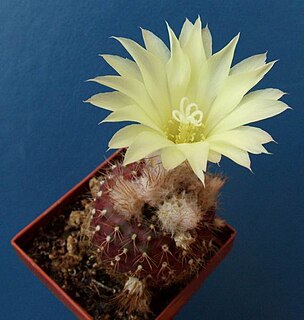
Frailea mammifera is a species of Frailea from Bolivia and Argentina.
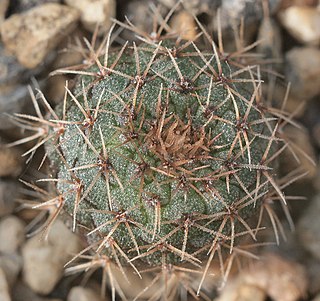
Frailea phaeodisca is a species of Frailea from Brazil and Uruguay.
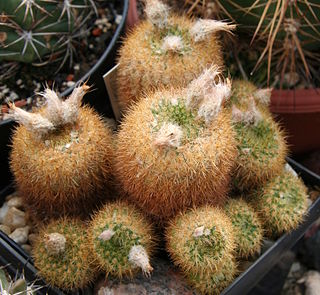
Frailea pumila is a species of Frailea from Brazil, Argentina, and Uruguay.
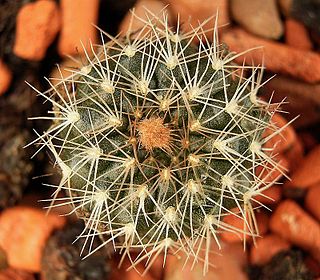
Frailea pygmaea is a species of Frailea from Bolivia, Argentina, and Uruguay.
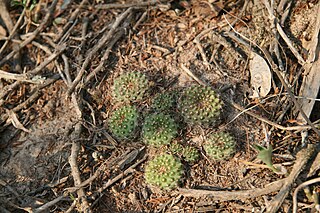
Frailea schilinzkyana is a species of Frailea from Brazil to Argentina.
Peltaea is a genus of flowering plants belonging to the family Malvaceae.
Claudia Vaca, full name Claudia Cecilia Vaca Flores, is a poet, fiction writer, essayist, and educator from Santa Cruz, Bolivia.

















